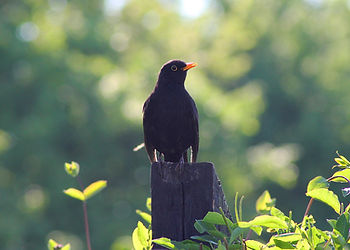Blackbird
(Turdus merula)
Alert Status: Green - 15% decline
Identifying Features: Male: Black with yellow beak female: dark brown
Average Length: 24-25 cm
Average Lifespan: 3 Years
Average Wingspan: 35 - 38 cm
Beak type: Generalist
Feeding: Natural Insects, worms, cotoneaster berries & windfall fruit
How to feed: Ground feeders & bird tables
What to feed: Peanuts, mealworms, berries, apples, raisins
Nesting: Hedges & shrubs
Where to see: Widespread across the UK. Gardens, rural, lawns



Fascinating Facts
The blackbird is a very familiar sight in our parks and gardens, one of the most common UK
birds. It is a member of the thrush family.
The males live up to their name, with their glossy black plumage but, confusingly, females are
brown often with spots and streaks on their breasts. The bright orange-yellow beak and eyering make adult male blackbirds one of the most striking garden birds, and easily
recognisable. Its mellow song is also a favourite and they like to sing after rain.
Male blackbirds establish a territory during their first year, which they will hold throughout
their lives.
Blackbirds can be found breeding in every European country except Iceland. Some British
blackbirds migrate for the winter, but most stay in the UK. One bird is even known to have
regularly migrated from Norfolk to Devon.
Blackbirds are soft-billed so struggle to deal with tough seeds and grain but will eat suet,
raisins and other kitchen scraps from the ground or a ground feeding table. More unusual
food has included taking tadpoles, newts, and small fish. In the autumn they will often spend
much time eating berries and windfall fruits (e.g. apples), which they will aggressively defend
from other birds.
Blackbirds can survive 16 to 20 years in the wild, but they rarely live for more than 2.5 years.
Cuckoos often lay eggs inside blackbirds' nests. Luckily, blackbirds easily recognize different coloured eggs and eliminate them from their nests.
In the Middle Ages, up to Shakespeare’s time, the blackbird was known by the old English
name of the Ouzel, Ousel or Wosle. This name is still sometimes used in Scotland. The first
recorded usage of the word 'blackbird' was in 1486 and even though there are bigger black birds in medieval England such as the crow, raven, rook or jackdaw, these were previously
regarded as fowl so the Ouzel was simply the largest black bird at that time. In A Midsummer
Night’s Dream, Shakespeare describes the bird as ‘The Woosell cocke, so blacke of hew, With
Orenge-tawny bill’.
First recorded in 1744, in England “Sing a Song of Sixpence” is a traditional nursery rhyme and
like many other old songs, the origin of this rhyme is unclear. The reference of blackbirds in a
pie didn’t appear in the first version of the song.
Sing a Song of Sixpence,
A bag full of Rye,
Four and twenty Naughty Boys,
Baked in a Pye!
Blackbirds cooked in a pie have been consumed as delicacies. In the 16th century, the birds
were sometimes used for practical jokes, where live blackbirds were put inside a pie, and they
were able to fly away from the pie when it was opened. These sophisticated recipes were for the King's amusement!

